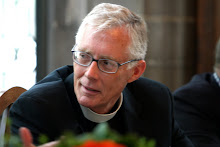What’s With All These Vampires and Zombies?
Today is Halloween, a holiday with several meanings. For Christians it’s the eve of All Saints Day; for young adults it’s an excuse for parties; for children it’s the funnest day of the year; for TV programmers it’s the time to schedule one more horror movie marathon.
Anyone who follows popular culture must be aware of the increasing number of vampire and zombie movies and television shows in recent years. For vampire fans, we have Twilight, The Vampire Diaries, and True Blood. For zombie aficionados, we have Death Valley, Dead Set, and Walking Dead. And for those who love the two types equally, there is the new show, Deadliest Warrior, which features face-to-face combat between both groups of the Undead.
Word has it that vampires are fading and zombies gaining the upper hand these days. However we understand their relative cultural power, though, it’s clear that this pervasive fixation on the Undead is saying something that we need to hear. Why do so many people in our world find that tales of vampires and zombies provide them meaningful parables of life and death?
Vampires come to us from medieval Eastern Europe, and it doesn’t take a genius to see how Balkan peasants would have made up stories about local nobility who were figuratively and literally bleeding them dry. Remember that Dracula is a nobleman, a count; he’s a representative of the elite who exacted blood and money from those who lived in fealty to them. In more modern accounts, vampires have morphed into scary monsters (the Dracula movies) and then into Romantic figures living beyond the grave.
Zombies derive from West African and Haitian varieties of Voodoo. Originally, zombies were those who had subjugated their will to a more powerful figure and existed thereafter to do that person’s bidding. In contemporary culture zombies have become emblems of the breakdown of civilization, traveling in hordes preying on the living and eventually turning the entire population into flesh-eating zombies. If the vampires were figurative predators, zombies were metaphorical prey. Either way, they projected images of power and its abuses.
However you think of vampires and zombies, their resurgence in the 21st century suggests some pervasive cultural worries that should make us people of faith take note. While vampires may live beyond the grave, their ongoing existence doesn’t seem to resemble what Christians would understand as resurrection. That younger people find vampires to be symbols of everlasting love should signal to us that the young don’t know much about the Christian hope. And the kind of disintegration the zombies usher in feels like a parodic vision of Armageddon: in zombie land, the world ends in an orgy of mutual predatory destruction, but it does not usher in the City of God.
In the 1930’s horror movies spoke to a shared experience of economic devastation. In the 1950s they expressed anxiety about living in the nuclear age. In the 21st century, the resurgence of vampire and zombie drama suggests another era of cultural dis-ease. Vampires live forever with romantic but without divine love. Zombies bring about social destruction that suggests judgment without redemption. Both visions tell us that many younger people experience the world as a predatory place. They see themselves hanging on in a world with little hope of joy or peace.
As Halloween modulates into All Saints’ Day, those of us who follow Jesus need to remember a couple of things. We should remember what the Christian hope really is. It’s a hope of resurrected life in Christ that redeems and transforms our lives and the world’s. We should proclaim that hope to a culture that confuses the vampire existence with eternal life. We should also remember that we share our world with people who increasingly find it a fearful and hostile place. What kind of a picture of God and human destiny are we in our witness showing to the world? What kind of comfort, care, and ministry are we providing for those who find life a frightening enterprise?
Vampires and zombies are abroad in our culture as signs of the pains and fears you and I as God’s loving agents should be attending to. They’re not just harmless monsters. They stand for what upcoming generations fear and dread the most. If we have eyes to see and ears to hear, we’ll let these creatures alert us to opportunities for love, service, and the proclamation of good news.
So much for my amateur cultural theoretics; take them for what they’re worth. Sometime I’ll share my thoughts (and strategies) on Angry Birds! Happy Halloween. And, more importantly, Happy All Saints’ Day.
Gary Hall

